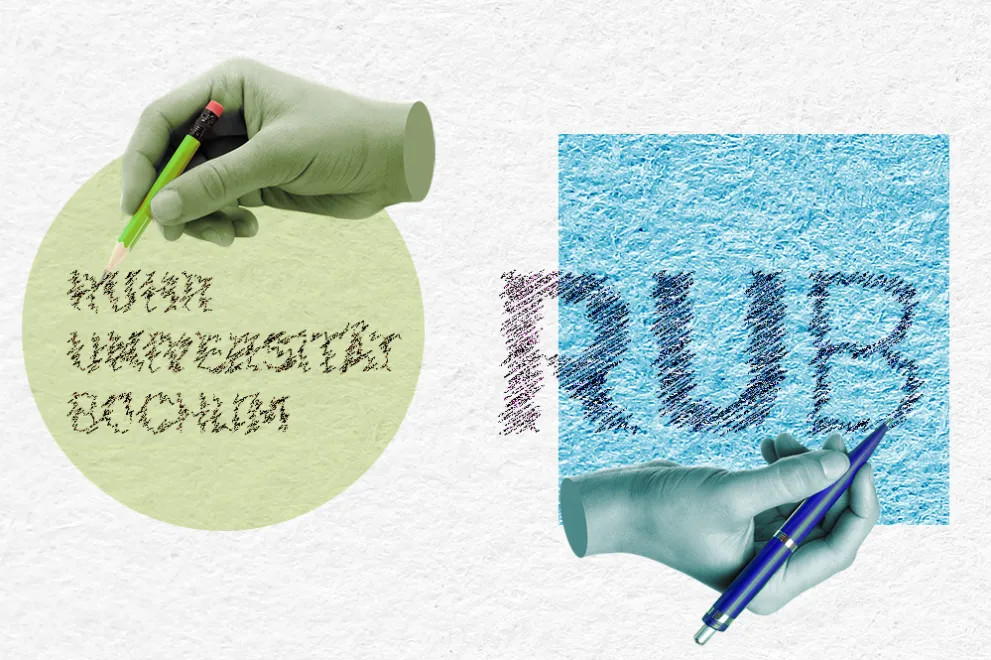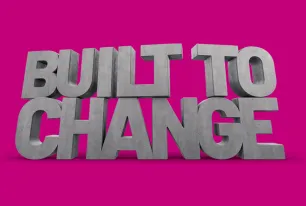In our needs assessment, we collected opinions, wishes and suggestions to ensure that the new design is tailored to the needs of all RUB members. Design guidelines are now being developed on this basis.

New Corporate Design for Ruhr University Bochum
The Ruhr University Bochum (RUB) brand claim “Built to change” stands for change and innovation. We want to bring this claim to life visually – with a new corporate design.
This website will keep you updated on the progress of the project.
A corporate design is the visible signature of an organization and forms the basis of its visual identity. It creates a uniform design language that informs the appearance of internal and external communication.
In addition to the logo, traditional elements of a corporate design include:
- Color scheme: A defined palette that supports the visual identity.
- Design language: Clear design principles that reflect the character of the organization.
- Iconography: Consistent symbols and pictograms for different applications.
- Imagery: Style and type of images that convey the organization’s values and messages.
- Composition: Rules for the arrangement of elements that ensure recognition and consistency.
In addition, the corporate design defines how these design elements are used in different types of media – as in printed and digital use cases.
A well thought-out corporate design unites form and function, ensures recognizability and conveys at first glance what an organization stands for.
Why a New Corporate Design?
The current corporate design of Ruhr University Bochum is already 15 years old. The requirements for communication and design have changed considerably in the meantime: Digital formats, accessibility and a clear visual language now play a central role.
- Accessibility: The current design does not fully meet today's requirements for accessibility and inclusion. For example, the RUB green in digital applications is difficult to recognize for some people.
- Internationality: Internationalization is a key issue for Ruhr University Bochum. In order to remain internationally visible and competitive, our university needs a modern design with a strong digital presence.
- Recognizability/continuity: Ruhr University Bochum's corporate design forms a stable basis, but more flexibility is needed for future development in order to meet today's communication requirements, especially in the digital field. In addition, a design diversity has developed over the years, which influences the recognizability of the brand Ruhr University Bochum.
Objectives of the New Corporate Design
The brand Ruhr University Bochum (RUB) remains clearly recognizable and easily identifiable. In discussions with representatives of all status groups, it has emerged that RUB wants to appear more self-confident, more varied and more flexible.
The new corporate design should ensure the following points:
- Brand mission statement: The design corresponds to RUB's brand mission statement and makes our values such as equal opportunities, diversity and change visible.
- Digitalization: The design meets digital requirements, including accessibility, and presents information – especially on the web – in a clearer, more user-friendly and appealing way.
- Representation: The design offers a unique selling point and is clearly recognizable in competition with other universities.
- Identification: The design strengthens affiliation by giving the RUB brand a face for students and staff.
- Practicality: The design simplifies visual communication and makes the creation of material more efficient by providing clear guidelines.
Our aim is to develop a corporate design that is modern, functional and appealing – for everyone who teaches, learns and works at RUB.

- Completed: Needs assessment
- Current: Design developement
- Brand portal concept
The project completion is planned for the first quarter of 2026.
Our revised design guidelines will then gradually be implemented in follow-up projects – for example on the websites.
Results of the Opinion Survey
The needs and wishes regarding the design of Ruhr University Bochum were collected in qualitative interviews, workshops and in an online survey to which all members of the university were invited. Around 700 people took part in the survey, around 43 percent of whom were students. The remainder were members of academic and administrative staff.
The main points of criticism concerned the fonts and the limited color palette of the current corporate design. For example, licensing problems and restrictions regarding fonts and special characters were cited as problematic.
Further feedback focused on the lack of accessibility of the current design, the lack of templates for various tools and a somewhat outdated design that does not meet the requirements for a competitive international image.
I want a design that conveys competence and uniformity – and is attractive and independent both nationally and internationally.
Goal of the Revision
A flexible and representative corporate design for Ruhr University Bochum that
- Makes values such as equal opportunities, diversity and change more visually tangible
- Meets the requirements of accessibility and new technical developments
- Ensures clear recognition in international competition
- Gives practical and flexible freedom for individual design within the framework of clear guidelines
- Visualizes and strengthens the university’s sense of unity
Next Steps
The next step is design development. This includes, for example
- Definition of design guidelines
- Creating an accessible color scheme
- Defining typography
- Development of an independent visual language
Revising the corporate design is a necessary investment, especially in times of crisis, increasing competition for funding and talent as well as decreasing student numbers. A competitive design that works well online in particular and is internationally up to date is becoming increasingly important in order to appeal to young target groups.
Of course, a design overhaul incurs costs. However, these are also incurred if the design is not adapted – outdated materials and templates make using the design unnecessarily time-consuming. 15 years ago, technological development was not as advanced as it is today, which is why the current design is not optimally suited to many modern use cases. Without clear guidelines, users often have to spend a lot of time and energy making design adjustments.
In the long term, investing in a design overhaul will reduce costs. Optimized administrative processes, especially in the digital area, can make numerous workflows more efficient. For example, forms or digital tools, such as apps, could be created more quickly and easily.
We are currently in the process of developing and coordinating the design, so unfortunately we cannot provide any precise information on the specific scope at this time.
However, the results of the needs assessment indicate that we will have to fundamentally revise the design in order to meet requirements in terms of color palette, typography, use in various media and platforms, and accessibility.
We would like to revise the RUB Design in the long term and are planning a transition phase, the exact details of which we are currently working out. We will provide all important information and updates on this project website.
We will use the results of our needs assessment to make the transition as easy and transparent as possible for everyone involved.
Project Participants
- The group is made up of members of the Corporate Communications Department
- The process is being supervised by the design and brand agency Radikant.
Project Management & Contact
Sonja
Israel
Templates, logo, colors, fonts, web:
